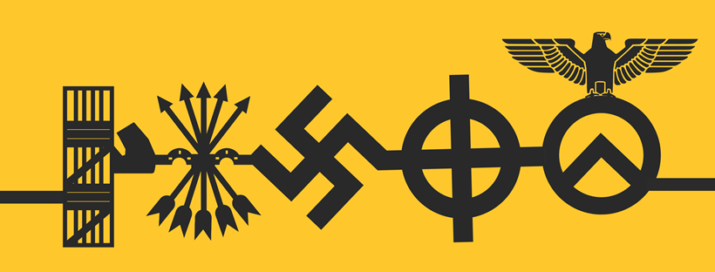

An introduction to Louie Dean Valencia-García’s series The Rise of the European Far-Right in the Internet Age.
Part I – Rise of an Esoteric Company: What is Arktos?
Part II – ABCs of Arktos: People, Ideas, and Movements
Part III – History Repeating Itself: The Rebirth of Far-Right Ideology and Internal Strife
Part IV – How Fascist is Arktos?: A Traditionalist Confronting Fascism
Part V – Generation Identity: A Millennial Fascism for the Future?
Beginning in 2005, a small Danish company called Integral Tradition Publishing (ITP) began building a network of nationalists, traditionalists, and white supremacists intent on creating an alternate vision of modernity—a lofty, if not seemingly impossible, task. The books they sold peddled the works of lesser-known fascist authors whose hands were seemingly less dirty—most prominently the Italian proto-fascist philosopher Julius Evola.[i] Today, Arktos Media, the British-based inheritor company to ITP, is headed by a former coal mining company C.E.O., Swedish nationalist Daniel Friberg. The evolution of Arktos/ITP represents a seismic shift of far-right ideologies from the periphery to the center, quite literally moving from Denmark to a Hare Krishna base in India to right-wing Hungary, and eventually settling somewhere between London and Washington D.C—with employees and contributors scattered globally.[ii] Arktos has grown into what AltRight.com writer Charles Lyons, who as of this past autumn serves as Head of Arktos US, has called the “biggest publisher of traditionalist, conservative, nationalist, Identitarian and overall alt-right literature in the World.”[iii]
Arktos’ books are easily available via their own website and the internet retailer Amazon. YouTubers and message boards dedicate themselves to the ideals proposed by many of the authors published by Arktos—decrying democracy, multiculturalism, “cultural Marxism,”[iv] and “degeneracy,” whilst lauding masculinity and nationalism, inciting Islamophobia. In fact, today, many of Arktos’ editors and authors are closely associated with proud American white nationalist, Richard Spencer. Over the course of this series, readers will be introduced to a hybrid print/digital publisher that has brought esoteric, fascist ideologies back from the grave. Each installment will delve into another aspect of the media company, outlining Arktos’ history, while describing more broadly the ways its collaborators are using both the internet and analogue media to promote fascistic ideologies.
The series will draw historical lines between fascism in Mussolini’s Italy, Spain’s Falangism, and neo-fascist youth movements in Europe today. While most historians rightfully delineate historical fascism from neo-fascist groups today, we can still certainly identify fascist tendencies that apply more broadly. Although there is no “fascist checklist,” or a fascist minimum for that matter, there certainly is a moment in which fascist tendencies are easily recognizable.[v]
This “draft history” of Arktos will explore the publisher’s ideological underpinnings, and explore how Arktos has promoted the rise of a fascistic, “Identitarian” trans-European youth movement, “Generation Identitaire” (Generation Identity), which has grown prominent in Austria, France, the United Kingdom, Norway, Germany, Spain, Italy, the United States, and beyond. With an eye toward understanding Arktos’ extension vis-à-vis print and digital technologies, over the course of this series, readers will be introduced to a selection of Arktos’ history, writers and publications to investigate the reception of that material in the public sphere.[vi] [vii]
Rise of an Esoteric Company: What is Arktos?
In 2005, Jacob Christiansen Senholt (b. 1983), a student studying at Aarhus University in Denmark, and Patrick Boch (b. 1983), a then recent graduate from the University of Buckingham in the United Kingdom, co-founded an online bookstore and publishing company, Integral Tradition Publishing—registering the company in their home country, Denmark.[viii] The company published several titles under its own imprint and sold books from other publishers on its website, IntegralTradition.com.[ix] ITP ostensibly sold and published texts on mysticism and the occult—books that promoted what the website described as “traditionalist” and “esoteric” worldviews. These ideologies often contained a mélange of nationalism and pre-modern religious practices—pre-Vatican II Catholicism, Eastern Orthodoxy, Zoroastrianism, Hinduism, Sufism, various forms of Nordic and Roman paganism, etc. Already, by the end of 2007, as many as 274,976 visits had been made to the ITP website.[x]
On ITP’s website, interested readers could find authors of the “European New Right,” a post-fascist Nationalist-Traditionalist ideology that arose in the aftermath of the Second World War. Nationalist-Traditionalists largely used so-called occult and traditionalist philosophy to obscure their fascistic ideologies.[xi] Many of the books listed as “most popular” on ITP’s website promoted both fascism and anti-liberalism, with titles such as, Metaphysics of War (Julius Evola); Religious Attitudes of the Indo-Europeans (Hans F.K. Günther); New Culture, New Right: Anti-Liberalism in Postmodern Europe (Michael O’Meara). Evola was a proto-fascist philosopher, Günther a Nazi eugenicist, O’Meara an advocate for a white ethno-state. ITP’s most popular book, Evola’s Metaphysics of War, was also the first book published by their imprint. Evola (1898-1974) was an aristocrat who was a leader of the Italian Dadaist movement, a prominent collaborator with Nazi-Fascists, and philosopher who proposed “traditionalist” ideology that was anti-egalitarian, anti-democratic, anti-liberal, anti-Christian, and anti-Semitic.[xii]
Despite decades of suppression of fascistic ideologies in the wake of the Nazi-Fascist genocide, today, new digital technologies have facilitated the creation of a space where such fervent nationalism (and neo-fascism) can once again find supporters—and more than just through Twitter, Reddit, 4chan, and other underbelly sites where fascistic ideologies fester.[xiii] While many elements of the extreme far-right were suppressed in the decades following the Holocaust, today, neo-fascists, white nationalists, far-right traditionalists, and new groups such as the “Identitarian Bloc” have used the internet to form an interconnected global movement by creating what I call “digital imagined communities”—to borrow from political scientist and historian Benedict Anderson.[xiv] The internet has facilitated the ideological reconstitution of the far-right, bringing back hateful discourses that once were either culturally taboo or illegal in many European countries after the Holocaust. While quicker knowledge distribution has sparked democratic uprisings—such as the Arab Spring—digital media publication has also allowed for the rise of anti-liberal, anti-democratic movements that extol “traditionalism” and white nationalism.
Today, Arktos specializes in publishing mostly short, readable texts by resurrected proto-fascist and New European Right philosophers, and a hotchpotch of pseudo-historical and mythological works that seek to restore what many of the ITP/Arktos authors convey as a lost sense of white European identity.[xv] To be clear, founder Jacob Senholt has described the European New Right as:
…a cultural and intellectual network presenting itself as working towards the preservation and rekindling of European culture, tradition and identity. It utilizes a metapolitical strategy aimed at inspiring a revolutionary change in the current cultural hegemony of the global liberal-democratic system, and works towards the establishment of new tribal communities.[xvi]
Rejecting pluralism, democracy, and globalism, Nationalist-Traditionalism has found appeal amongst the disenfranchised libertarian-minded, religious, white, working class in Europe—and increasingly in the United States. Often, Nationalist-Traditionalists show a propensity for scapegoating minority groups. Whereas many practitioners of esotericism and traditionalism once eschewed Christianity as a non-European tradition,[xvii] ITP/Arktos has accepted more orthodox iterations of Christianity as a category of traditionalism.[xviii] Today, many of their most recent texts reflect an admixture of European paganism and more conservative iterations of Christianity.
Because of ITP, and publishers like it, the ideas of one of the founding figures of esoteric-traditionalist thought, Julius Evola, have gained new interest amongst this sect of right-wing extremists, particularly in the present-day writings (and YouTube rants) of Russian Traditionalist Alexander Dugin, who both publishes with Arktos and is a known advisor to Russian President Vladimir Putin.[xix] However, this combination of nationalism and traditionalism is hardly new. Nationalist-Traditionalism was present in early Nazism,[xx] and a Christianized version of this worldview also has precedent in the National-Catholicism found under the dictatorship of Francisco Franco in Spain (1936-1975).[xxi] Today’s Nationalist-Traditionalists have found common enemies in the Enlightenment values of rationalism, secularism, and liberalism—an antagonism perhaps most infamously present in Steve Bannon’s worldview, a Catholic who has lauded nationalism and traditionalism and also served as White House Chief Strategist and campaign manager for American President Donald Trump.[xxii]
Arktos has unexpectedly become a nexus between Russian Nationalism, the European New Right, and the American Alt-Right.[xxiii] Through a case study of Arktos, we can better understand a rising anti-democratic, anti-liberal, anti-globalist, anti-modern, global network that desires a white ethno-state founded on “traditionalist” ideologies. ITP/Arktos has recognized how print can be more effective than digital technology in some cases, and vice-versa, allowing them to create a variety of ways to “unite the right”—and to appeal to new audiences. As future installments in this series will show, Arktos is attempting to play the long game, with the singular goal in mind: re-writing history by proposing a fascistic future.
Louie Dean Valencia-García, Ph.D. is an Assistant Professor of Digital History at Texas State University. He has taught in the Faculty of Arts and Sciences at Harvard University, and serves on the Research Editorial Committee for EuropeNow. His forthcoming book Antiauthoritarian Youth Culture in Francoist Spain: Clashing with Fascism will be published by Bloomsbury Academic in May 2018. He has held fellowships from the Andrew W. Mellon Foundation, the United States Library of Congress, the Spanish Ministry of Education, Culture and Sport, and Santander Universities, amongst others. This essay is part of a collection in-progress, Alt-Histories: Far-Right Revisionism and the End of History.
References:
[i] Née Giulio Cesare Andrea Evola.
[ii] The Metapolitics of Arktos – Speech by John Morgan @ Identitarian Ideas VII (2015), perf. John Morgan, YouTube.com, November 20, 2015, accessed June 16, 2017, https://www.youtube.com/watch?v=0qV2QTJr_Hk.
[iii] Charles Lyons, “The Birth of Arktos and Its Role in the Alt-Right,” AltRight.com, June 01, 2017, archived June 5, 2017, https://web.archive.org/web/20170605205918/https://altright.com/2017/05/31/the-birth-of-arktos-and-its-role-in-the-alt-right/.
[iv] For the European New Right, and the American Alt-Right, “cultural Marxism” is meant as a derogatory turn of phrase used to describe the interdisciplinary and intersectional academic methodological framework commonly known as “critical theory,” which draws on influences from the likes of Italian Marxist Antonio Gramsci, who popularized the concept of “Hegemony” in his Prison Notebooks. Included in the New Right’s definition of “cultural Marxism” one might also find authors prominent in what was the Frankfurt School, originated at the Institute for Social Research at the Goethe University in Frankfurt, Germany, which sought to understand issues of class in relation to ethnocentrism, nationalism, and race. Later scholars have augmented issues of gender, sexuality, bodies, etc.—expanding critical theory to understand more complicated systems of oppression.
[v] Some of these tendencies include: an attempt to impose an idea of purity or homogeneity onto others, an idealized and utopian future based on a romanticized, imagined past, and a use of binary and absolutist categorization that promotes nationalism, ethnocentrism, anti-intellectualism, racism, misogyny, queerphobia, ableism, classism, and anti-liberalism. Tactically, fascism is appropriative of other movements, uses ritual and mystical symbolism, and relies upon false information, propaganda. Adamantly against individualism, fascism advocates for militarism, violence, surveillance, and expansion of an authoritarian state’s powers. In its more extreme instances, it holds colonialist ambitions, desires a nation-centric economy, and relies on forced labor and genocide for the supposed purpose of returning a fatherland, or country, to greatness. See: Louie Dean Valencia-García, Antiauthoritarian Youth Culture in Francoist Spain: Clashing With Fascism (Bloomsbury USA Academic, 2018), 40-41.
[vi] I use what I call “digital archival excavation” to situate that recent history of the publisher and its relationship with the rise of the European far-right/alt-right through the use of the Internet Archive (www.archive.org) and by scouring webpages and sites that are preserved or abandoned in the recesses of the internet. I define digital excavation as a methodological process that uses websites such as the Internet Archive (http://www.archive.org), which attempt to “capture” websites. The Internet Archive does not always capture all the pages of a given website, but do often take multiple captures of a given page, which facilitates user’s ability to see changes made to a given page over time. Additionally, other sources include photographs and text from Arktos collaborator’s personal websites, editorial pieces, social media, and videos posted to the website, YouTube.com, from their conferences, interviews, etc.
[vii] In my footnotes, when citing from the Internet Archive, I will not note when I “accessed” the website, but instead will indicate when the archive’s web crawler archived the page, as that will more accurately reflect the information and context of the digital document. To this point, when a scholar visits an archive they do not cite the date that they viewed the document, unless for some particularly significant reason. Instead, they cite the date of record for the document. Using the Internet Archive, scholars can see both the date of publication of an article (if indicated) and the date of capture—which do not always align. In my citations, when referring to the Internet Archive, I will indicate the date the webcrawler “archived” the page. In cases when I am citing a website that is not archived by the Internet Archive, I have marked my date of access, and have saved a copy of the site as it appeared when I visited it in my own records.
[viii] The company was registered in Århus, Denmark by Christiansen and Boch on 1 November 2005 and was closed on 31 December 2009. “Integral Tradition Publishing I/S V/Jacob Christiansen Og Patrick Boch,” https://data.virk.dk/, accessed August 11, 2017, https://datacvr.virk.dk/data/visenhed?enhedstype=virksomhed&id=29051895&soeg=29051895&language=en-gb.
[ix] At first, only Senholt and Boch were listed on the ITP website’s “About” page. Others, such as John Morgan, also have claimed to be co-founders as well, though there does not seem to be an indication of that either on the website of documents filed. See: “About Us,” Integral Tradition Publishing, archived March 15, 2007, https://web.archive.org/web/20070315013345/http://www.integraltradition.com:80/catalog/about.php.
[x] Counting began on August 19, 2006. The number was likely larger. Integral Tradition Publishing, archived December 27, 2007, https://web.archive.org/web/20071227175659/http://www.integraltradition.com:80/catalog/index.php.
[xi] This traditionalist school can be thought of as a variant of the Nouvelle Droite, or European New Right, which came into being in the 1960s under the direction of right-wing philosopher Alain de Benoist and his Groupement de recherche et d’études pour la civilisation européenne (GRECE), which took cues from proto-fascist, esoteric/traditionalist philosopher Julius Evola.
[xii] Nicholas Goodrick-Clarke, Black Sun: Aryan Cults, Esoteric Nazism, and the Politics of Identity (New York: New York University Press, 2003), 53.
[xiii] For more on 4chan, Reddit and Tumblr, see: Angela Nagle, Kill All Normies: The Online Culture Wars from Tumblr and 4chan to the Alt-Right and Trump (Winchester, UK ; Washington, USA: Zero Books, 2017). While these websites have garnered a fair amount of attention, the focus of this essay is not those well-known sites.
[xiv] See Benedict Anderson, Imagined Communities: Reflections on the Origin and Spread of Nationalism (London: Verso, 2006).
[xv] I use “ITP” to describe the earlier years of the press, “Arktos” when specifically discussing the post-ITP years, and “ITP/Arktos” when discussing a broader scope that includes both projects.
[xvi] Jacob Christiansen Senholt, “Radical Politics and Political Esotericism: The Adaptation of Esoteric Discourse within the Radical Right,” in Contemporary Esotericism, ed. Egil Asprem and Kennet Granholm (Acumen Publishing, 2012), 248.
[xvii] Ibid., 256.
[xviii] “About Us,” Integral Tradition Publishing, archived March 15, 2007, https://web.archive.org/web/20070315013345/http://www.integraltradition.com:80/catalog/about.php.
[xix] Today, one of the most prominent proponents of traditionalism globally, and an early influence on ITP, Alexander Dugin (b. 1962), has called for “neo-Eurasianism,” a nationalism that is thought of better suited for Russia, one that could include the Russian Federation, Ukrain, Belarus, and even the Islamic world. For more background on Dugin’s philosophy, see: Mark J. Sedgwick, Against the Modern World: Traditionalism and the Secret Intellectual History of the Twentieth Century (Oxford: Oxford University Press, 2009), 221-240.
[xx] The swastika itself was religious symbol that typically meant “good luck,” and is found in Hinduism and Buddhism, amongst other world religions. Famously, Heinrich Schliemann discovered its use in the ancient site of Troy, and considered it a lost religious symbol in Europe. See: Thomas Wilson, The Swastika: The Earliest Known Symbol, and Its Migration; with Observations on the Migration of Certain Industries in Prehistoric Times (Washington DC: Smithsonian Institution, 1896), 771.) Many German national movements concerned with völkisch traditions appropriated the swastika, and tied it to Aryanism. For more on the ways occultism influenced early Nazism, see: Nicholas Goodrick-Clarke, The Occult Roots of Nazism: Secret Aryan Cults and Their Influence on Nazi Ideology (New York: New York University Press, 2004).
[xxi] For more on National-Catholicism, see chapter two of my upcoming book Antiauthoritarian Youth Culture in Francoist Spain: Clashing with Fascism (London: Bloomsbury Academic, 2018).
[xxii] J. Lester Feder, “This is how Steve Bannon sees the entire world,” BuzzFeed, November 15, 2016, archived November 17, 2016, https://web.archive.org/web/20161117025150/https://www.buzzfeed.com/lesterfeder/this-is-how-steve-bannon-sees-the-entire-world?utm_term=.hu7gJKGlW#.fmpeLRbnA
[xxiii] Indeed, the connection between the Alt-Right and white nationalism has become so established that in November 2016 the Associated Press advised journalists: “[W]henever “alt-right” is used in a story, be sure to include a definition: “an offshoot of conservatism mixing racism, white nationalism and populism,” or, more simply, “a white nationalist movement.” See: John Daniszewski, “Writing about the ‘alt-right’,” November 28, 2016, archived November 28, 2016, https://web.archive.org/web/20161128203006/https://blog.ap.org/behind-the-news/writing-about-the-alt-right.
Published on February 1, 2018.
Photo: Louie Dean Valencia Garcia, The image presented here are not transferrable to any THIRD PARTY, and are not to be printed, published or used in any way for any other article, publication or marketing event without prior written consent/agreement.




